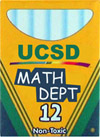|
Math TA Training Presentation on Problem-Solving, April 30, 2007
This is problem-solving for TAs, not for course instructors. You aren't in control of curriculum, pacing, or course organization; you're running problem sessions, for problems already selected, assigned and solved.
Shifting responsibility from the TA to students. As much as possible, students should present solutions, explain reasoning, raise and debate questions and methods.
- Students need the practice using terminology, articulating reasoning, and defending conclusions.
- The more they talk, the more the TA learns about their proof schemes, understanding of terminology, pronunciation, interpretation of problem task, misconceptions, and tacit assumptions.
- Arbiter of correctness should be group consensus on reasoning/justification/check, not the TA or the back of the book.
- Students may be less intimidated by each other than by you, feel freer to challenge methods or insufficient justification.
- If TA presents solutions, at least get students to say where they got stuck and how they knew they were stuck.
- Ask questions for group discussion as you proceed, and raise conceptual issues.
- Be aware of the Topaze effect: correct student answers to a series of simple questions do not indicate understanding.
References on student cognition in problem-solving:
G. Polya, How to Solve It
Alan Schoenfeld, Mathematical Problem Solving
Polya: Stages in problem-solving:
- Understand the problem.
- Make a plan.
- Carry out the plan.
- Reflect.
Schoenfeld: Tools for problem-solving:
Algorithms/resources, heuristics, manager/control/metacognition, subgoal generation, reflection.
- Some common student beliefs about problem-solving: problems are solved in under 10 minutes, by algorithms/procedures, answers checked against authority, if I forget a formula I cannot reconstruct it.
- Reasoning largely empirical even when relevant theorems are known.
- Procedure selected by matching surface features of problem with an example from class/book, whereas experts attend to "deep structure".
- But, how to distinguish between surface features and deep structure of problem before solving it?
Students memorize without understanding, can't apply knowledge from theorems, don't know meaning of symbols on their cheat sheets.
The most crucial phases of the problem-solving process are (1) understanding the problem and (2) reflection, both of which are often omitted.
Understanding the problem.
- What do the words in the problem mean?
- What is the situation described? Can I draw a picture?
- What is given, and what must be found/proved/done?
- How will I tell when I have found it?
- What's my conjecture/estimate as to the answer?
- Who cares?
- Do I know an example? (Examples are not proofs, but a common underlying reason is.)
- Do I know an applicable theorem? (Student difficulty applying theoretical knowledge.)
- Failure to understand/appreciate problem leads to problem-free activity.
Students execute rote procedures under specified conditions because it's expected, illuminating the confict "What am I supposed to do?" vs "What does this mean?" Thus "the problem" for students becomes determining what's expected, or forcing the problem situation into the prescribed framework.
Reflection on the solution.
- Now, what is the surface vs deep structure?
- How would I recognize such a problem on an exam? (Out of textbook sequence.)
- Why was this problem assigned?
- How much of the answer could have been anticipated?
- How can the answer be checked? What justified it? Does it make sense? What does it mean?
- How does the answer change if parameters or assumptions vary?
- Are alternative solution methods available, easier, faster, more illuminating/elementary?
- How would I describe/explain my solution to someone else?
- What theorems, algorithms, methods did I use? Did I have to?
- What new conjectures, generalizations, or questions does the solution suggest?
Preparation for section should include working out alternate approaches to problems, anticipating student errors, questions, difficulties. An important question to ask is: What concepts underlie the problem and how can I probe student understanding of these?
"What do we do next?" may not be a good question. Better ones:
- "What does this mean?" - always good! Meaning of symbols, equations.
- "How do we know this?" (Or, "What causes this to be true?")
- "What does this computation prove?" Necessity/sufficiency, quantifiers.
- "Is there another way?" (Or, "What happens if we do this instead?")
- "What is a possible plan/subgoal?"
- "How can we check the answer?"
- "What if we modify the problem by...?"
- "Why was this problem assigned?"
|
 Teaching Tips > Notes from Jeff Rabin
Teaching Tips > Notes from Jeff Rabin
